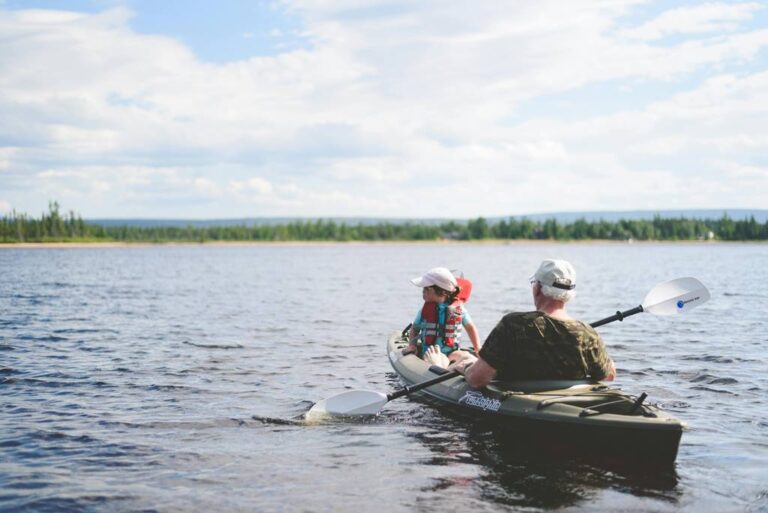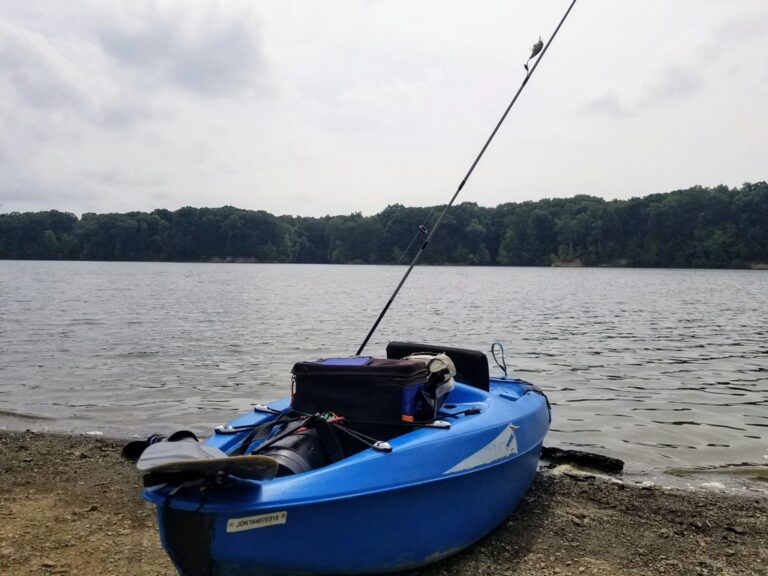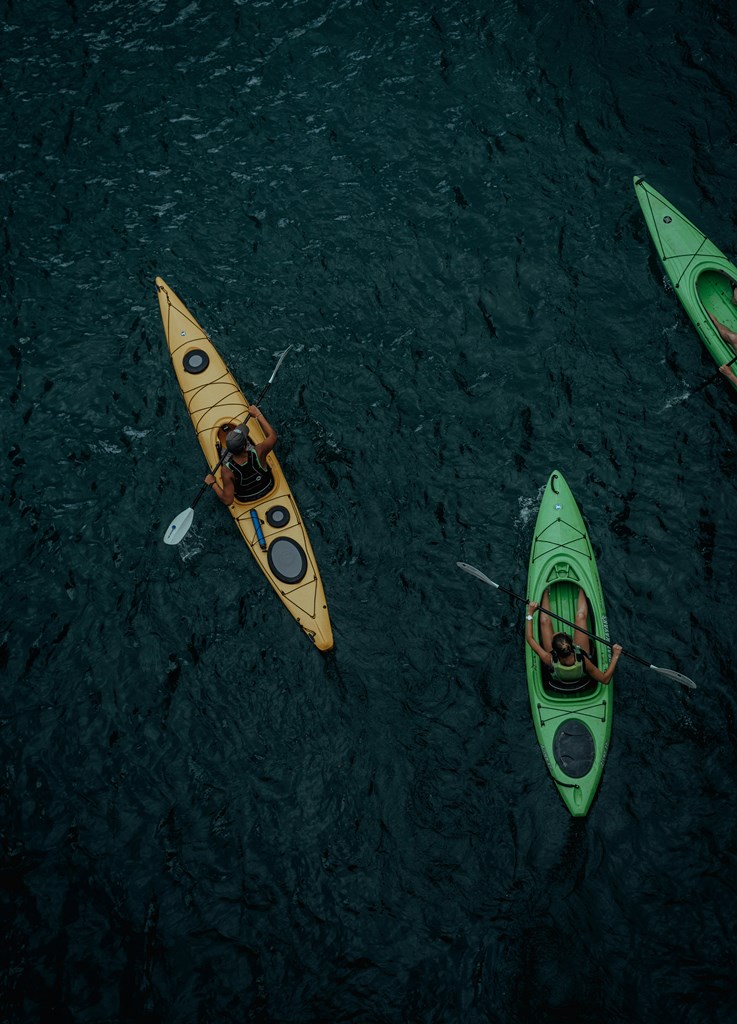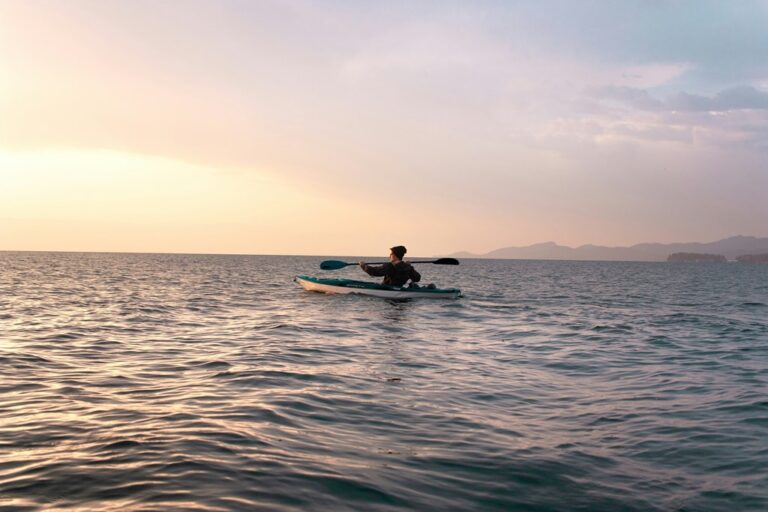
Table of Contents
The health advantages of kayaking are numerous, offering a welcome escape from the hustle and bustle of daily life. From improving cardiovascular health to enhancing mental well-being, the holistic advantages of paddling extend far beyond the mere enjoyment of the sport. Join us as we delve into the depths of this rejuvenating activity and discover how you can paddle your way to a healthier, more vibrant life.
Health Benefits of Kayaking: Paddle Your Way to Wellness
In today’s world, prioritizing heart health is more important than ever. The good news is, that you don’t need to spend hours at the gym to achieve a healthier cardiovascular system. Kayaking, a seemingly serene activity, offers a surprisingly effective way to strengthen your heart and improve overall cardiovascular health. Let’s delve into the science behind kayaking and explore how paddling your way through the water can translate to a healthier, happier you.
Elevating Your Heart Rate: The foundation of a strong cardiovascular system lies in a healthy heart rate. Kayaking provides a fantastic cardiovascular workout by elevating your heart rate into a target zone for sustained periods. As you paddle steadily, your heart works harder to pump blood throughout your body, delivering oxygen and nutrients to your muscles. This sustained increase in heart rate strengthens the heart muscle itself, allowing it to pump more blood with each beat, ultimately improving its overall efficiency.
Burning Calories for a Healthy Weight: Cardiovascular health isn’t just about heart rate; it also involves weight management. Kayaking is a fantastic calorie-burning exercise. The rhythmic motion of paddling engages various muscle groups, including your arms, core, and legs. This sustained exertion burns significant calories, which helps you maintain a healthy weight. Maintaining a healthy weight is crucial for reducing the risk of heart disease, as excess weight puts additional strain on your heart.
Beyond Calories: Building Endurance: While calorie burning is a significant benefit, kayaking offers an additional advantage in terms of cardiovascular health: building endurance. As you continue paddling, your body becomes more efficient at utilizing oxygen during exercise. This translates to increased stamina and a longer time spent in your target heart rate zone. This improved endurance translates to a healthier heart that can handle physical activity more efficiently, reducing the risk of heart disease in the long run.
Lowering Stroke Risk: Stroke, a leading cause of disability, occurs when blood flow to the brain is interrupted. Kayaking offers a double whammy in reducing stroke risk. Firstly, by strengthening your heart and improving circulation, it helps maintain healthy blood flow throughout your body, including the brain. Secondly, the weight management benefits of kayaking can help regulate blood pressure, another crucial factor in preventing strokes.
The Beauty of Low-Impact Exercise: Unlike many high-impact exercises, kayaking is gentle on your joints. This makes it an excellent option for people of all ages and fitness levels, especially those with pre-existing joint conditions. You can still reap the cardiovascular benefits of kayaking without the added stress on your knees, ankles, and back.
Kayaking: A Fun and Accessible Path to Heart Health
Kayaking offers a unique combination of enjoyment and cardiovascular benefits. You can explore scenic waterways, and get some fresh air and sunshine, all while giving your heart a much-needed workout. Whether you’re a seasoned paddler or a complete beginner, kayaking is an accessible and enjoyable way to improve your cardiovascular health. So, grab your paddle, embrace the water, and paddle your way to a stronger, healthier you!
Calorie-Burning Adventures in Kayaking
In the quest for a healthy lifestyle, many people crave activities that combine exercise with enjoyment. Kayaking emerges as a frontrunner, offering a thrilling escape into nature while secretly harboring a powerful weapon in the fight against weight gain – calorie burning. Forget the monotony of the treadmill; with kayaking, you can burn significant calories, manage your weight, and embark on scenic adventures, all in one exhilarating package.
The magic of kayaking lies in its ability to engage various muscle groups simultaneously. Unlike isolated gym exercises, kayaking utilizes your core, arms, and legs dynamically. Every stroke you take requires your core to stabilize your torso, your arms to pull and push the paddle, and your legs to brace against the footrests. This full-body workout translates into a significant calorie burn, helping you create a calorie deficit – the key to weight management. Studies suggest that an hour of moderate-intensity kayaking can burn anywhere between 300 to 400 calories, depending on your weight and intensity.
The beauty of kayaking lies in its adaptability. You can tailor your paddling experience to match your fitness level and desired calorie burn. A leisurely cruise along a calm lake will provide a moderate workout while navigating choppy waters or battling against a strong current will significantly ramp up your calorie expenditure. This scalability makes kayaking accessible to people of all fitness levels.
Beyond the calorie-burning potential, kayaking offers a low-impact advantage. Unlike high-impact exercises like running or jumping, kayaking minimizes stress on your joints. This is particularly beneficial for those with pre-existing joint conditions or those new to exercise. The low-impact nature allows you to enjoy an effective workout without the fear of injury, making kayaking a sustainable and enjoyable path to weight management.
The most compelling aspect of kayaking, however, might be its ability to transform exercise into an adventure. Imagine gliding across a crystal-clear lake surrounded by breathtaking scenery, the gentle sound of your paddle slicing through the water. Or picture navigating through a network of mangrove forests, teeming with vibrant birdlife. Kayaking allows you to explore hidden coves, witness stunning sunrises over calm waters, or tackle challenging rapids in whitewater adventures. The scenic backdrop keeps you motivated and engaged, making the calorie-burning aspect a pleasant side effect rather than the central focus.
Kayaking isn’t just about aesthetics; it fosters a sense of accomplishment and a deeper connection with nature. As you paddle your way through a challenging course or conquer a long-distance journey, you build self-confidence and resilience. The serenity of the water combined with physical exertion creates a sense of mindfulness, reducing stress and promoting mental well-being.
So, if you’re looking to shed some weight, improve your overall fitness, and embark on unforgettable adventures, consider trading the gym for the open water. Kayaking offers a unique blend of calorie-burning, low-impact exercise, and breathtaking exploration. Grab your paddle, embrace the beauty of nature, and unlock a world of calorie-burning adventures on the water.
Empowering Your Upper Body: Building Strength with Kayaking
Kayaking often evokes images of serene glides across tranquil waters. However, beneath this seemingly peaceful exterior lies a hidden gem – a fantastic way to build upper body strength. Unlike weightlifting or gym machines that isolate specific muscles, kayaking engages multiple muscle groups dynamically and functionally. It’s a full-body workout disguised as a leisurely paddle, sculpting and strengthening your upper body without the need for bulky equipment.
The core of kayaking’s upper body benefit lies in the act of paddling itself. Every stroke you take is a symphony of muscle activation. Your biceps and triceps take center stage, firing with each pull and push of the paddle. With each stroke, these muscles are challenged to generate power, leading to increased definition and strength in your arms.
But the benefits extend beyond your biceps and triceps. Your shoulders are constantly engaged throughout the paddling motion. The act of stabilizing the paddle and initiating each stroke requires significant shoulder strength and stability. Kayaking helps develop this crucial muscle group, improving your ability to perform everyday activities that involve reaching and lifting, all while reducing the risk of shoulder injuries.
The hidden hero in kayaking’s upper body workout is your core. Maintaining a stable and upright position in your kayak requires the constant engagement of your core muscles, particularly the abdominals and obliques. These muscles act as a bridge between your upper and lower body, transferring the power generated from your arms to propel the kayak forward. As you paddle, your core is constantly working to maintain proper posture and counterbalance the twisting motion of your torso with each stroke. This sustained engagement strengthens your core, leading to improved posture, better balance, and a flatter stomach.
Kayaking isn’t just about sculpted arms and a strong core; it also strengthens your back muscles. The act of pulling the paddle towards your body engages your upper back muscles, promoting better posture and reducing back pain. Additionally, the twisting motion involved in paddling strengthens your obliques, which are crucial for spinal stability and overall core strength.
The beauty of kayaking’s upper body workout lies in its functional nature. Unlike isolated gym exercises, kayaking utilizes your muscles in a coordinated way, mimicking real-life movements. This translates to increased strength and control in everyday activities, making it easier to lift groceries, carry heavy objects, or perform tasks that require upper body strength.
Furthermore, kayaking is a fantastic option for people with limited mobility or those recovering from injuries. Unlike weightlifting, which can put stress on joints, kayaking is a low-impact exercise that allows you to build upper body strength without the risk of injury. The water supports your body weight, minimizing strain on your joints while still providing a challenging workout.
So, the next time you head out for a kayaking adventure, remember that you’re not just enjoying the scenery; you’re also on a mission to empower your upper body. With every paddle stroke, you’re building strength, improving posture, and enhancing your overall functional fitness. It’s a win-win for your health and well-being, all while surrounded by the beauty of nature.
Strengthening the Core: Balancing Act in Kayaking
Kayaking, often perceived as a serene and scenic pastime, is a surprisingly effective exercise that secretly targets a crucial muscle group – the core. This powerhouse of muscles, encompassing the abdominals, obliques, and lower back, forms the foundation for all movement and is essential for maintaining good posture, balance, and stability. Kayaking, with its unique demands on core engagement, becomes an unexpected yet rewarding core strengthening workout.
The core muscles play a central role in keeping you upright and stable in your kayak. Unlike a stationary exercise machine, a kayak is a dynamic platform that responds to water conditions. Currents, wind, and even your paddling strokes can cause the kayak to wobble or tilt. To maintain balance and prevent tipping, your core muscles are constantly engaged in micro-adjustments. Every twist of your torso to initiate a stroke, every subtle shift to compensate for a wave, and every counter-movement to maintain posture – all rely on a strong core.
This constant engagement strengthens your core muscles over time. The repetitive twisting and turning motion of paddling specifically targets the obliques, the muscles on the sides of your torso responsible for rotational movement. As these muscles become stronger, your body becomes more efficient at transferring power from your upper body to your paddle stroke, leading to smoother and more powerful paddling.
But core strength in kayaking goes beyond just keeping you upright. A strong core provides a stable base for your upper body movements. As you pull the paddle through the water, the force needs to be transmitted through your core to the kayak. A weak core will struggle to transfer this force efficiently, leading to wasted energy and less effective strokes. On the other hand, a strong core will act as a solid bridge, allowing you to channel the power from your upper body into propelling the kayak forward with greater efficiency.
The benefits of core strength in kayaking extend beyond just physical performance. Improved core stability translates to better balance in everyday life. Activities like walking, climbing stairs, and even simply standing for long periods become easier and more comfortable. Additionally, a strong core can help alleviate back pain by improving posture and reducing strain on the lower back.
While kayaking offers a natural core workout, focusing on proper paddling techniques can further enhance its effectiveness. Engaging your core muscles deliberately with each stroke, maintaining good posture with a straight back and engaged core, and practicing controlled torso rotation will maximize the core strengthening benefits of kayaking.
So, the next time you head out for a kayaking adventure, remember that you’re not just enjoying the scenery; you’re also giving your core a valuable workout. With every paddle stroke, you’re building strength, stability, and balance, both on the water and in your everyday life.
Enhanced Endurance
In today’s world, prioritizing physical fitness and building endurance are crucial for a healthy lifestyle. Kayaking, often perceived as a leisurely activity, offers a surprising secret weapon – the ability to build impressive endurance. Whether you’re gliding across serene lakes or battling challenging currents, kayaking progressively improves your stamina and overall fitness, leaving you feeling energized and ready to conquer any adventure.
The key to kayaking’s endurance-building power lies in its sustained, low-impact nature. Unlike high-intensity exercises that quickly deplete your energy reserves, kayaking engages various muscle groups rhythmically and continuously. As you paddle steadily, your body adapts to the demands placed upon it, gradually increasing its ability to utilize oxygen efficiently. This translates to increased stamina, allowing you to paddle for longer durations without experiencing fatigue.
With each paddling session, your body undergoes a series of physiological adaptations. Your mitochondria, the powerhouses of your cells, become more efficient at producing energy. Your capillaries, the tiny blood vessels that deliver oxygen to your muscles, increase in number, ensuring a steady supply of oxygen to meet the increased demand. These adaptations allow you to sustain paddling efforts for longer periods without feeling drained, significantly boosting your endurance.
The beauty of kayaking lies in its ability to cater to all fitness levels. Beginners can start with shorter paddling sessions and gradually increase the distance and duration as their stamina improves. More experienced paddlers can push their limits by tackling longer routes, challenging currents, or incorporating interval training techniques. This adaptability makes kayaking an excellent tool for building endurance, regardless of your starting point.
Beyond the physiological benefits, kayaking fosters a mental resilience that translates to improved endurance. The act of paddling for extended periods demands focus and determination. As you navigate through various conditions, pushing through fatigue and overcoming challenges, you build a mental fortitude that carries over into other aspects of life. This newfound mental strength allows you to persevere through difficult tasks and maintain motivation when faced with obstacles.
Furthermore, kayaking offers a mind-body connection that enhances the endurance-building experience. The rhythmic motion of paddling creates a sense of mindfulness, allowing you to focus on your breath and movements. This meditative aspect reduces stress and anxiety, which can often hinder performance and sap your energy reserves. By combining physical exertion with mental focus, kayaking promotes a holistic approach to building endurance.
The benefits of kayaking’s endurance-building effects extend beyond the water. Improved stamina translates to increased energy levels throughout the day. You’ll find yourself tackling everyday tasks with more ease, experiencing less fatigue, and recovering faster from physical activity. This enhanced endurance spills over into your overall fitness, allowing you to participate in other activities with greater enjoyment and performance.
So, if you’re looking for an enjoyable and effective way to build endurance, consider grabbing a paddle and embarking on a kayaking adventure. Whether you choose to explore tranquil waters or challenge yourself in more demanding conditions, kayaking offers a unique blend of physical exertion, mental resilience, and a connection with nature. With each paddle stroke, you’ll be building stamina, improving overall fitness, and unlocking a world of possibilities, all while enjoying the beauty of the open water.
Fluid Motion: Impact on Joint Flexibility
In the quest for a healthy lifestyle, many activities prioritize strength and endurance, often overlooking the crucial role of joint flexibility. Kayaking emerges as a hidden gem, offering a gentle yet effective way to improve joint flexibility through its fluid and low-impact nature. Unlike high-impact exercises that can strain joints, kayaking allows you to move your body in a continuous and controlled manner, promoting healthy joints and a wider range of motion.
The secret to kayaking’s joint-friendly benefits lies in its low-impact nature. Unlike running, jumping, or weightlifting, kayaking minimizes the stress placed on your joints. The water supports your body weight, reducing the impact on your knees, ankles, and hips. This makes kayaking an accessible activity for people of all ages and abilities, including those with pre-existing joint conditions or those new to exercise. Regular paddling sessions can help to maintain healthy cartilage, cushioning material between your bones, promoting pain-free movement and improved joint health.
The fluid motion of kayaking plays a key role in enhancing joint flexibility. As you paddle, your body goes through a series of controlled movements throughout a wide range of motion. Your shoulders rotate as you pull and push the paddle, your spine twists slightly with each stroke, and your hips engage as you brace against the footrests. These repetitive movements, when done with proper form, help to lubricate your joints and increase their range of motion. Over time, you’ll notice increased flexibility in your shoulders, hips, and spine, making everyday activities like reaching overhead, bending down, or twisting your torso feel more effortless.
Beyond the immediate benefits, kayaking promotes long-term joint health by helping to maintain good posture. The act of paddling requires you to sit upright and engaged, strengthening the muscles that support your spine. This improved posture helps to reduce stress on your joints and prevents misalignment, which can lead to pain and discomfort in the long run. Additionally, the low-impact nature of kayaking allows you to exercise regularly without the risk of overuse injuries, a common concern for activities that put excessive stress on your joints.
The beauty of kayaking’s impact on joint flexibility lies in its gentle and progressive nature. You can tailor your paddling experience to your current level of flexibility. Beginners can start with shorter sessions and gradually increase the duration and intensity as their range of motion improves. This allows for gradual improvement without the risk of overexertion or injury.
Furthermore, kayaking offers a mind-body connection that enhances the experience for your joints. The rhythmic motion of paddling creates a sense of mindfulness, allowing you to focus on your breath and movements. This reduces stress and muscle tension, which can contribute to joint stiffness. By combining physical movement with mental focus, kayaking offers a holistic approach to improving joint flexibility.
The benefits of kayaking’s impact on joint flexibility extend beyond the water. Improved joint mobility translates to increased ease in everyday movements. You’ll find yourself bending, reaching, and twisting with greater ease, enhancing your overall performance in other activities. Additionally, maintaining healthy joints reduces the risk of pain and discomfort, allowing you to live an active and fulfilling life well into your golden years.
So, if you’re looking for a gentle and enjoyable way to improve joint flexibility, consider grabbing a paddle and embarking on a kayaking adventure. Whether you’re a seasoned paddler or a complete beginner, kayaking offers a unique blend of low-impact exercise, improved posture, and a mind-body connection. With each paddle stroke, you’ll be nurturing your joints, increasing your range of motion, and unlocking a world of pain-free movement and activity.
Uplift Your Mood: The Mental Benefits of Kayaking
The modern world, with its relentless demands and constant stimulation, can leave our minds feeling like a churning sea. Yet, there’s a simple antidote nestled amongst the glistening ripples – kayaking. This seemingly unassuming activity unlocks a treasure trove of mental health benefits, offering a tranquil escape that soothes the soul and uplifts your mood. Let’s delve into the psychological advantages of kayaking and discover how paddling your way through nature can calm the inner storm.
Beyond stress relief, kayaking offers a potent dose of nature therapy. Immersing yourself in the natural world has a profound impact on mental well-being. The gentle lapping of water against the hull, the symphony of birdsong, and the ever-changing tapestry of clouds overhead work together to create a sensory haven. Studies have shown that spending time in nature reduces symptoms of anxiety and depression, promotes feelings of calmness, and fosters a sense of awe and wonder. Kayaking allows you to fully immerse yourself in this restorative environment, nurturing your mental well-being with each stroke.
One of kayaking’s greatest gifts is its profound ability to melt away stress. The rhythmic motion of the paddle strokes becomes a form of meditation in motion. With each pull and push, your focus narrows to the present moment, the worries of the day receding like the shoreline behind you. This repetitive action creates a calming rhythm, mimicking the soothing effect of waves lapping against the shore. As your mind quiets, stress hormones like cortisol dip, replaced by a wave of tranquility that washes over you.
The feeling of accomplishment that comes with kayaking further bolsters your mood. As you navigate through unfamiliar waters, conquer challenging currents, or simply reach a predetermined destination, you’ll experience a surge of pride and satisfaction. These small victories, coupled with the physical exertion of paddling, contribute to a sense of self-efficacy, boosting your confidence and overall mood.
Kayaking also fosters a sense of connection – a connection with yourself and the natural world around you. The quiet solitude on the water allows for introspection and self-reflection. Away from the constant noise and distractions of daily life, you have the space to reconnect with your inner voice, process emotions, and gain clarity on personal challenges. Additionally, kayaking allows you to connect with the natural world on a deeper level. You become an observer, appreciating the intricate dance of life unfolding around you, from playful otters to majestic birds soaring overhead. This connection with nature fosters a sense of belonging and grounding, leaving you feeling more centered and at peace.
The mental benefits of kayaking extend far beyond the time spent on the water. The sense of calm and focus gained during your paddling adventure spills over into your daily life. You’ll find yourself approaching challenges with greater clarity, managing stress more effectively, and experiencing a general sense of well-being that permeates all aspects of your life.
So, the next time you feel overwhelmed by the complexities of life, consider grabbing a paddle and embarking on a kayaking adventure. It’s a journey not just across the water, but also towards a calmer, more centered state of mind. Let the rhythmic strokes and the embrace of nature guide you towards mental serenity, one paddle stroke at a time.
Summary
Kayaking offers a refreshing escape from daily stress. The rhythmic paddling and natural surroundings work together to soothe your mind and uplift your mood. It’s more than just exercise; kayaking nourishes your soul by connecting you with nature and fostering a sense of accomplishment. So, grab your paddle, embrace the water, and discover the holistic benefits of this invigorating activity!






